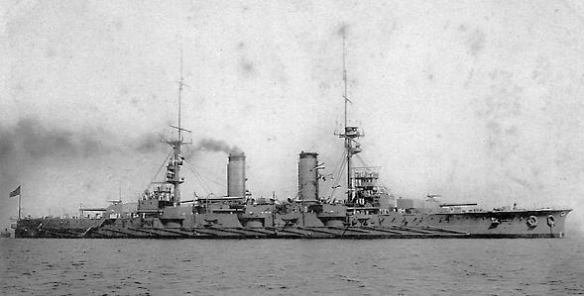
Satsuma was a semi-dreadnought type battleship of the Imperial Japanese Navy, designed and built in Japan by the Yokosuka Naval Arsenal. The name Satsuma comes from Satsuma Province, now a part of Kagoshima prefecture. Some naval historians regard the battleship Aki as her sister ship, although Aki differed considerably with her turbine-powered engine and sleek silhouette.
Funding for Satsuma was approved as part of the 1904 Emergency Budget for the Russo-Japanese War, and she was the first battleship to be designed and built domestically in Japan. The basis of the design was essentially a modified version of the Royal Navy’s Lord Nelson class battleship and many parts were sourced from the United Kingdom.
Satsuma was the first ship in the world to be designed and laid down as an all-big-gun battleship, although gun shortages caused HMS Dreadnought to be the first one to be completed. She was also the largest battleship in the world at the time of her launch, which was witnessed by Emperor Meiji
“Laid down before Dreadnought and intended to carry 12-inch guns, she should have been completed as the world’s first all-big-gun battleship. However there were not enough Armstrong 1904 pattern 12-inch guns available, and 10-inch guns had to be substituted for all but four of the weapons. Thus, it was that future all-big gun battleships were to be called “dreadnoughts”, and not “satsumas”.” (Jane’s “Battleships of the 20th century”).
When completed, the Satsuma had four 12″ 50-caliber guns plus twelve 10″ guns onboard. Both Satsuma and the all-big-gun 1908 USS South Carolina (BB-26) lacked the other major advance in British ship technology — the move from triple expansion steam engines to steam turbines for propulsion.
After commissioning at Yokosuka on March 25, 1906, Satsuma was assigned to the IJN 1st Fleet. The Satsuma was launched on November 15, 1906 and later participated in World War I, patrolling the sea lanes south of Japan, in the South China Sea and the Yellow Sea, and assisting in the occupation of the former German Caroline Islands, and in the Battle of Tsingtao.
After the war, Satsuma was used as a support vessel, to cover the landings of Japanese troops in Russia during Japan’s Siberian Intervention.
Satsuma was scrapped to comply with the provisions of the 1922 Washington Treaty, and was used as a target, being sunk by gunfire 30 nautical miles (56 km) northeast of Miyakejima from the Kongō and Hyūga on September 7, 1924.